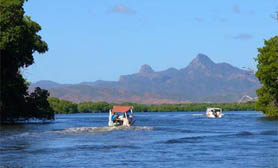Campeche | Miguel Colorado of Cenote
Away from the coast, these rainforests are interspersed with savannah areas and along the coast are accompanied by areas with sand dunes, mangrove wetlands and estuaries. Rainforest areas subdivide into a number of types which include perennial tall tree rainforest, semi perennial tall tree rainforest, deciduous medium height tree rainforest, semi deciduous medium height tree rainforest, deciduous low height tree rainforest and semi perennial low height tree rainforest. Plat and tree species that can be found in the various rainforests include huapaque, cedar (cedrela Mexicana), pukte (bucida buceras), sapote, dyewood (haematoxyllum campechianum), dzalam (lysiloma bohamensis) and more. Also known for a number of precious tropical hardwoods such as red cedar, mahogany, ciricote (cordia dodecandra) and (guialum sanctum) guayacán. Through the coastal areas, palms prevail such as the royal palm and coconut. The predominant wildlife species in the state are the ocelot, puma, deer, wild boar, jaguar, raccoon, hare, ring-tailed cat and spider monkey. There are many bird species including the ducks, quail, pelicans, chachalaca, toucan, buzzard and numerous others. Reptiles comprise of rattlesnakes, coral snakes, boa constrictors, various species of sea and land turtles, crocodiles and iguanas. Diving off the coast is in most of the state you´ll find abundant aquatic life including many species of fish, crustaceans and mollusks.
The rivers in the south and southwest belong to various basins, with the largest being the Grijalva-Usumacinta to which the Candelaria, Chumpán and Mamantal Rivers belong. Most of the state’s surface freshwater is in the south and southwest, with rivers, small lakes and estuaries. These diminish in the north where rainfall rapidly filtrates into the subsoil. The San Pedro River is another branch is the Usumacinta, which passes by the community of Jonuta in Tabasco before emptying in the Gulf. The Usumacinta also flows in the state but it tends to change course frequently and occasionally divides into branches. The east branch of this river is also called the Palizada River, which has the largest volume although it is narrow. The Chumpán River is an isolated river formed by the union of various streams. It runs north-south and empties in the Laguna de Terminos. The Mamantel River empties into the Laguna de Panlau. The Campotón River is in the center of the state and empties into the Gulf. The rest of the states streams flow only in the rainy season. The Candelaria River forms in Petén, Guatemala and runs north-south and empties into the Laguna de Pargos.




